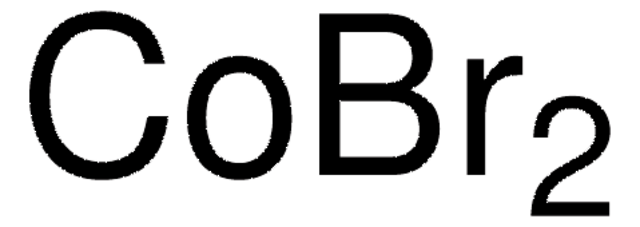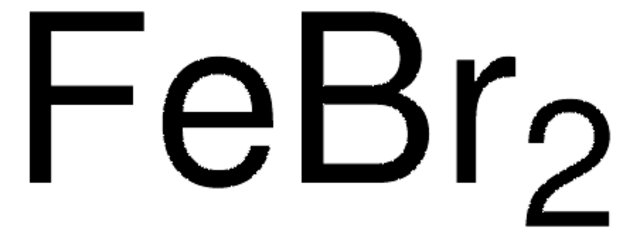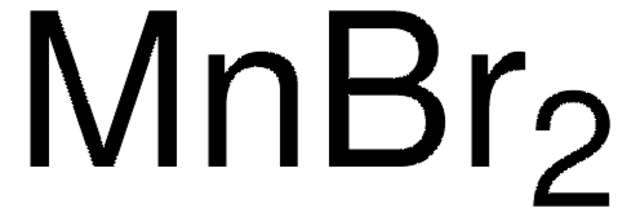334022
Cobalt(II) bromide
99%
Sinonimo/i:
Cobaltous bromide, Dibromocobalt
About This Item
Prodotti consigliati
Grado
for analytical purposes
Livello qualitativo
Saggio
99%
Stato
powder
Punto di fusione
678 °C (lit.)
Solubilità
acetone: soluble(lit.)
ethanol: soluble(lit.)
methanol: soluble(lit.)
Densità
4.909 g/mL at 25 °C (lit.)
applicazioni
battery manufacturing
Stringa SMILE
Br[Co]Br
InChI
1S/2BrH.Co/h2*1H;/q;;+2/p-2
BZRRQSJJPUGBAA-UHFFFAOYSA-L
Cerchi prodotti simili? Visita Guida al confronto tra prodotti
Applicazioni
- Synthesis, crystal structure and thermal properties of dibromidobis (2-methylpyridine N-oxide-κO) cobalt (II): This study provides insights into the crystal structure and thermal properties of a cobalt(II) bromide complex, highlighting its potential applications in materials science (Näther & Jess, 2024).
- Coordination complexes of isoquinoline with cobalt and nickel halides: The study describes the formation of coordination complexes using cobalt(II) bromide with isoquinoline, which could be used for further exploration in coordination chemistry (Bellerive et al., 2024).
Avvertenze
Danger
Indicazioni di pericolo
Consigli di prudenza
Classi di pericolo
Acute Tox. 4 Oral - Aquatic Acute 1 - Aquatic Chronic 1 - Carc. 1B - Muta. 2 - Resp. Sens. 1 - Skin Sens. 1
Codice della classe di stoccaggio
6.1C - Combustible acute toxic Cat.3 / toxic compounds or compounds which causing chronic effects
Classe di pericolosità dell'acqua (WGK)
WGK 3
Punto d’infiammabilità (°F)
Not applicable
Punto d’infiammabilità (°C)
Not applicable
Scegli una delle versioni più recenti:
Possiedi già questo prodotto?
I documenti relativi ai prodotti acquistati recentemente sono disponibili nell’Archivio dei documenti.
I clienti hanno visto anche
Articoli
Lithium-Ion Battery Performance: Dependence on Material Synthesis and Post‑Treatment Methods
We presents an article about a micro review of reversible addition/fragmentation chain transfer (RAFT) polymerization. RAFT (Reversible Addition/Fragmentation Chain Transfer) polymerization is a reversible deactivation radical polymerization (RDRP) and one of the more versatile methods for providing living characteristics to radical polymerization.
Tools for Performing ATRP
Applying ARGET ATRP to the Growth of Polymer Brush Thin Films by Surface-initiated Polymerization
Protocolli
Sigma-Aldrich presents an article about RAFT, or Reversible Addition/Fragmentation Chain Transfer, which is a form of living radical polymerization.
We presents an article featuring procedures that describe polymerization of methyl methacrylate and vinyl acetate homopolymers and a block copolymer as performed by researchers at CSIRO.
Sigma-Aldrich presents an article about the typical procedures for polymerizing via ATRP, which demonstrates that in the following two procedures describe two ATRP polymerization reactions as performed by Prof. Dave Hadddleton′s research group at the University of Warwick.
Global Trade Item Number
| SKU | GTIN |
|---|---|
| 334022-250G | 4061838138972 |
| 334022-50G | 4061826737729 |
Il team dei nostri ricercatori vanta grande esperienza in tutte le aree della ricerca quali Life Science, scienza dei materiali, sintesi chimica, cromatografia, discipline analitiche, ecc..
Contatta l'Assistenza Tecnica.














